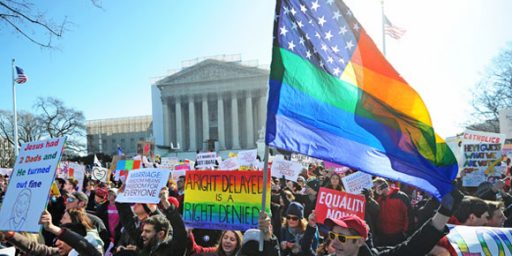Supreme Court Allows Trump Refugee Ban
The Supreme Court has overruled a lower court ruling blocking the Trump administration’s temporary ban on refugees. By the time they issue a final ruling, the issue will be moot.
Mark Sherman for the AP:
The Supreme Court is allowing the Trump administration to maintain its restrictive policy on refugees.
The justices on Tuesday agreed to an administration request to block a lower court ruling that would have eased the refugee ban and allowed up to 24,000 refugees to enter the country before the end of October.
The order was not the court’s last word on the travel policy that President Donald Trump first rolled out in January. The justices are scheduled to hear arguments on Oct. 10 on the legality of the bans on travelers from six mostly Muslim countries and refugees anywhere in the world.
It’s unclear, though, what will be left for the court to decide. The 90-day travel ban lapses in late September and the 120-day refugee ban will expire a month later.
White House spokeswoman Sarah Huckabee Sanders said Tuesday night: “We are pleased that the Supreme Court has allowed key components of the order to remain in effect. We will continue to vigorously defend the order leading up to next month’s oral argument in the Supreme Court.”
The administration has yet to say whether it will seek to renew the bans, make them permanent or expand the travel ban to other countries.
Lower courts have ruled that the bans violate the Constitution and federal immigration law. The high court has agreed to review those rulings. Its intervention so far has been to evaluate what parts of the policy can take effect in the meantime.
The justices said in June that the administration could not enforce the bans against people who have a “bona fide” relationship with people or entities in the United States. The justices declined to define the required relationships more precisely.
A panel of the San Francisco-based 9th U.S. Circuit Court of Appeals upheld a district judge’s order that would have allowed refugees to enter the United States if a resettlement agency in the U.S. had agreed to take them in.
The administration objected, saying the relationship between refugees and resettlement agencies shouldn’t count. The high court’s unsigned, one-sentence order agreed with the administration, at least for now.
While I don’t like the policy, the ruling is correct. The notion that the ruling of an administrative agency in the Executive branch is binding on the Chief Executive is, frankly, absurd.





You’re not seeing the second act?
“We were never able to get the Travel and Refugee Bans implemented , so we were never able to get the heightened vetting for these people taken care of. So my new executive order to finally establish the travel and refugee bans so that we can address the issue of extreme vetting goes into effect starting tomorrow.”
Wash. Rinse. Repeat. (With new court challenges based on the argument that the government had adequate time to address its concerns.)
I think it will actually be very important to establish who exactly controls U.S. immigration policy, what are the legitimate grounds to challenge that policy, and to reinforce the very idea that having an immigration policy is appropriate and legitimate.
Mike
@Just ‘nutha ig’nint cracker: @MBunge: Theoretically, the case becomes moot once the ban expires, eliminating the case in controversy and thus SCOTUS jurisdiction.
@James Joyner:
Except they’re already moot by the Administration’s own timeline. What this is an blatant attempt at long-term goalpost moving that one has to have some serious blinders on not to see. It’s a way to bypass the legal process and abuse executive privilege on something they know damn well they can’t pass through regular channels. It’s bad precedent to boot – do we *really* want a President that can issue such draconian restrictions “for 90 days” that doesn’t actually end 90 days later? Give that power to a Democrat and see how it tastes.
The Supreme Court should issue a request to see the plan that the Administration has been working on and its state of completion. By virtue of the legal process’ duration, it should be in its final stages by now. If the Administration cannot provide their work, it shows a lack of good faith effort and no intention to comply with any directive the Court may issue. Essentially, the Administration plans to waste the Court’s time over and over again rather then do its job. SCOTUS and the lower court are their own branch of government, not where Trump can punt things he wants to linger. It’s not their job to do his.